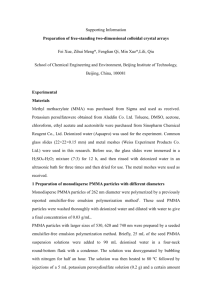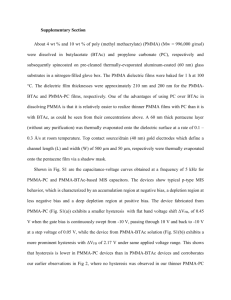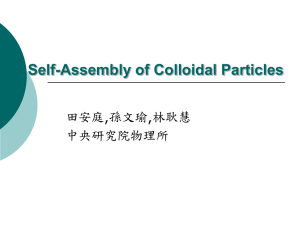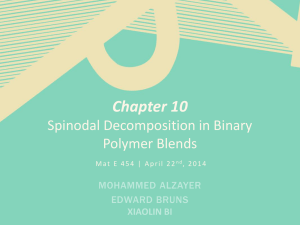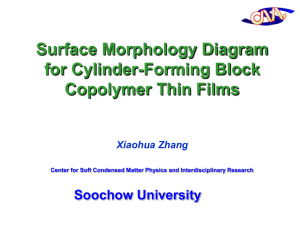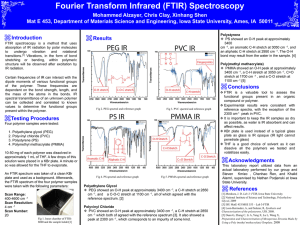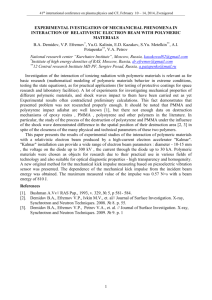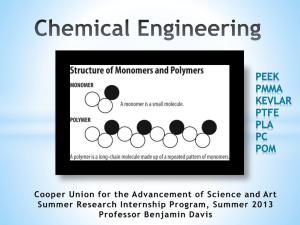Different strategies have been proposed in order to enhance its
advertisement
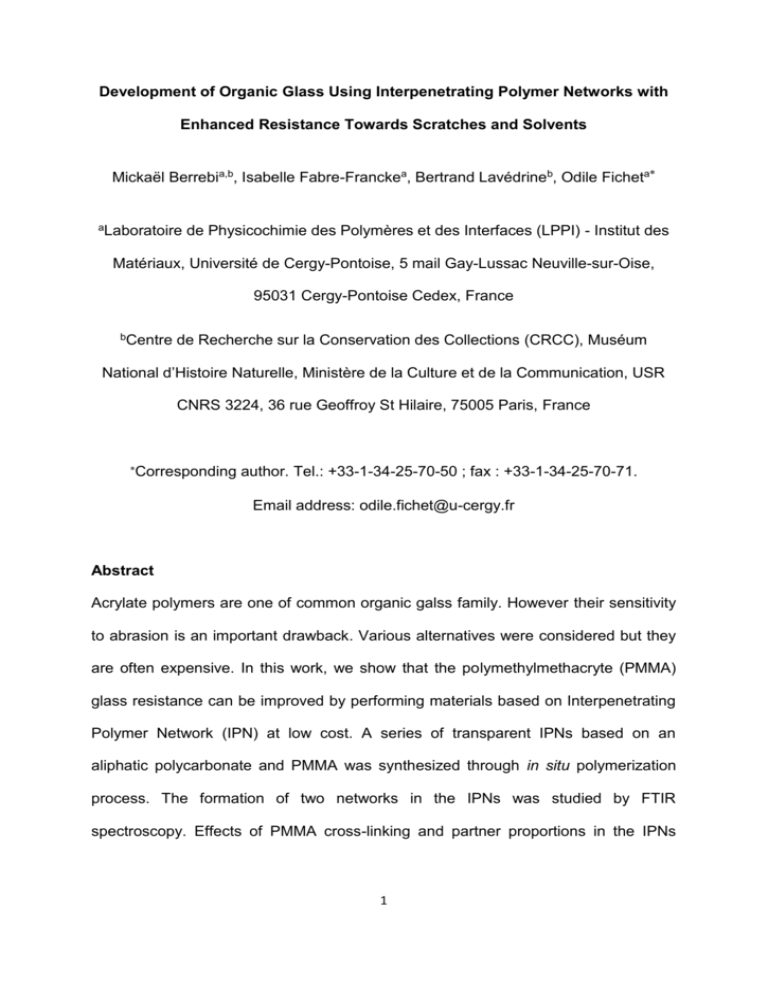
Development of Organic Glass Using Interpenetrating Polymer Networks with Enhanced Resistance Towards Scratches and Solvents Mickaël Berrebia,b, Isabelle Fabre-Franckea, Bertrand Lavédrineb, Odile Ficheta aLaboratoire de Physicochimie des Polymères et des Interfaces (LPPI) - Institut des Matériaux, Université de Cergy-Pontoise, 5 mail Gay-Lussac Neuville-sur-Oise, 95031 Cergy-Pontoise Cedex, France bCentre de Recherche sur la Conservation des Collections (CRCC), Muséum National d’Histoire Naturelle, Ministère de la Culture et de la Communication, USR CNRS 3224, 36 rue Geoffroy St Hilaire, 75005 Paris, France Corresponding author. Tel.: +33-1-34-25-70-50 ; fax : +33-1-34-25-70-71. Email address: odile.fichet@u-cergy.fr Abstract Acrylate polymers are one of common organic galss family. However their sensitivity to abrasion is an important drawback. Various alternatives were considered but they are often expensive. In this work, we show that the polymethylmethacryte (PMMA) glass resistance can be improved by performing materials based on Interpenetrating Polymer Network (IPN) at low cost. A series of transparent IPNs based on an aliphatic polycarbonate and PMMA was synthesized through in situ polymerization process. The formation of two networks in the IPNs was studied by FTIR spectroscopy. Effects of PMMA cross-linking and partner proportions in the IPNs 1 were investigated by dynamic mechanical thermal analysis. Optical properties, solvent and scratch resistances have been also studied. Keywords: Polycarbonates; Polymethylmethacrylate; Interpenetrating polymer networks; Surfaces and Interfaces; Mechanical properties 1. Introduction Poly(methyl methacrylate) (PMMA) is one of the most widely used compounds in the manufacture of organic glasses. Indeed it has a refractive index (n = 1.491 [1]) close to that of glass (n = 1.522 [2]), it has a better light transmission and is much lighter and less brittle than glass. Therefore it has been widely applied, PMMA is even still used by many artists to produce artworks such as Diasec© (a popular face mounting techniques for photographs), 3D objects and design furniture. Unfortunately PMMA is very sensitive to abrasion and after a few years this might alter its optical properties. Different strategies have been proposed in order to enhance its scratch resistance. PMMA may be loaded with functionalized nanoparticules. For instance, the presence of 3wt% CaCO3 nanoparticles functionalized with stearic acid doubles scratch resistance of PMMA [3]. PMMA was also copolymerized from TiO2 nanofiber and nanoparticles modified with methacrylic acid [4]. However, the difficulty resides in obtaining a homogeneous environment where the charges are well dispersed in PMMA matrix. 2 Another possibility to improve the mechanical properties of PMMA is to combine it with other polymers. Nevertheless the main problem with polymer blends is their general thermodynamic incompatibility leading to a phase separation in final materials. Interpenetrating Polymer Networks (IPN) architectures allow resolving this drawback. IPN is defined as a combination of at least two cross-linked polymers in which one of the polymer networks is synthesized in the presence of the other polymer network [5]. The presence of crosslinks limits phase separation between polymers compared to usual blends. The aim of these types of polymer associations is generally to obtain materials with better mechanical properties, dimensional stability and a possibly improved combination of the properties of its components. Thus, PMMA has been mainly associated in IPN architecture with elastomers such as polyurethane [6], polyisobutylene [7], natural rubber [8] or polybutadienepolyurethane [9] networks. In this last case, the tensile strength of polybutadienepolyurethane network was twice increased when it was associated with 40 wt% PMMA. PMMA has also been combined in IPN architecture with poly(carbonateurethane) (PCU) elastomer network (Tg= - 46°C) [10-12]. These IPNs are characterized by only one glass transition temperature between those of PCU and PMMA networks. PCU/PMMA IPNs show performance enhanced than those of single networks, and those of corresponding semi-IPNs and graft copolymers of PMMA and PCU which are biphasic [13]. For instance, IPNs are thermally more stable and have a higher ultimate strength than graft copolymers. PMMA has been also combined with thermoplastic polymers in (semi-)IPN architecture. For instance, PMMA has been combined with cellulose acetate (CA) [14]. CA/ PMMA (50/50) material provided an outstanding performance in both 3 ductility and tenacity. Similarly, tensile properties of poly(2,6-dimethyl-1,4-phenylene oxide) (PPO) were improved in PPO / PMMA IPNs [15]. A maximum tensile strength of 8300 psi was reached with 20 wt% PMMA against 6200 psi without PMMA. Similarly, the elongation at break of poly(vinyl chloride) was increased from 120 to 200% when it is entrapped inside a PMMA network (semi-IPN architecture) at 40wt% proportion [16]. In all cases, PMMA improves mechanical properties of its partner network. Polycarbonate (PC) is another polymer family widely used in the organic glass industry [17]. Especially, poly(allyl diglycol carbonate), known as PCR39 ®, is used to manufacture eyeglasses. As PMMA, PCR39® has also been the subject of several studies for its integration in interpenetrating polymer networks. For instance, to improve its impact resistance, it has been combined with cellulose acetate butyrate (CAB) [18]. IPNs containing between 90 and 72 wt% PCR39® were transparent unlike the corresponding semi-IPNs. These IPNs show better chemical resistance and an enhanced UV protection as well as an increased in their damping properties in comparison with those of the single PCR39® network. In another study, PCR39®/ rigid PU (50/50) IPN show a break elongation 4 times higher than that of the unmodified PCR39® and PU homopolymers [19]. The present work is intended to combine PMMA and polycarbonate PCR39 ® inside IPN architecture. In order to address specific issue of organic glass applications, specifications require a transparent final material and a preparation without solvent. Those IPNs are thus synthesized according an in situ sequential process in which all precursors are mixed together. The network formations are investigated by near FTIR 4 spectroscopy. The mechanical properties of IPNs are assessed by dynamic mechanical thermal analysis. Effects of polymer compositions and crosslinking density on the IPN properties are also studied. Moreover, considering the use of these IPNs as organic glass, their behaviors towards UV-visible radiation, abrasion and solvents are discussed. 2. Experimental Section 2.1. Materials Diethylene glycol bis-allyl carbonate (CR39®) (Aldrich), methyl methacrylate (MMA) (Acros organics 99%), dicyclohexyl peroxidicarbonate (DCPD) (group Arnaud), ethylene glycol dimethacrylate (EGDMA) (Aldrich 98%) and dichloromethane (GPR Rectapur® VWR) were used as received. Benzoyl peroxide (BPO) (Aldrich 75%) was dried under vacuum at room temperature for 24 h before use. For the FTIR study, MMA was washed with aqueous 0.5 wt% NaOH solution then with pure water to eliminate the methyl hydroquinone inhibitor, its removal was checked by UV spectrophotometry analysis. 2.2. Preparation of materials Single PCR39® network was prepared by dissolving 50 mg (0.21 mmol) BPO in 1 g (3.6 mmol) CR39®. The mixture was degassed under argon and then poured into a mould made from two glass plates clamped together and sealed with 1 mm thick Teflon® gasket. The mould was then kept in an oven at 80 °C for 2 h and post-cured at 100 °C for 2 h. A rigid transparent material was obtained. 5 Single PMMA networks were synthesized with different cross-linking densities. They were prepared by mixing 1 g (10 mmol) MMA with different EGDMA amounts (3, 5 or 10 wt% with respect to MMA) and 5 mg (30 mol) DCPD free radical initiator (0.5 wt% with respect to MMA). The mixture was degassed under argon and then poured into the mould previously described. The mould was then kept at 35 °C for 3 h and post-cured at 80 °C for 1 h. Rigid transparent materials were also obtained. They are noted PMMAx in the text where x is the weight proportion of EGDMA added to crosslink PMMA. PCR39®/PMMAx (50/50) IPN was synthesized as follows: 1 g (10 mmol) MMA was mixed with 1 g (3.6 mmol) CR39® and EGDMA (x = 3, 5 or 10 wt% with respect to MMA). Then 5 mg (30 mol) DCPD (0.5 wt% with respect to MMA) and 50 mg (0.21 mmol) BPO (5 wt% with respect to CR39®) were added. The solution was degassed under argon and then poured into a mould, as described previously. The mould was heated in an oven at 35 °C for 3 h, at 80 °C for 2 h and 100 °C for 1 h. IPNs with different PCR39® network contents ranging from 25 to 75 wt% were synthesized keeping the same proportions between MMA and EGDMA (x = 3 wt% EGDMA) and between CR39® and BPO initiator (5 wt% BPO). The DCPD amount was equal to 0.5 wt% with respect to MMA, except for PCR39®/PMMA3 (75/25) IPN for which DCPD amount was increased to 1 wt%. All investigated PCR39 ®/PMMA3 compositions were reported in weight by weight ratio. Thus, an IPN obtained from a mixture of 0.25 g CR39® and 0.75 g MMA will be denoted PCR39®/PMMA3 (25/75) IPN. The index 3 of PMMA corresponds to the EGDMA weight proportion in the PMMA network. 2.3. Material analyses 6 PMMA and PCR39® network formations were followed in real time by FTIR spectrometry. IPNs were directly synthesized in a small size IR cell constructed with two glass plates separated by 1 mm thick Teflon® gasket for each experiment, inserted in an electrical heating jacket with an automatic temperature controller (Graseby Specac) which set temperature within +/- 1 °C. The near-infrared spectra were recorded with Brücker spectrometer (Equinox 55) in the range 7000-1800 cm-1 by averaging of 16 consecutive scans with a resolution of 4 cm-1. Scan accumulations were repeated every 5 min. In order to estimate the extent of the network formation, materials were extracted in a Soxhlet with dichloromethane for 72 h. After extraction, the sample was dried under vacuum and then weighted. The extracted content (EC) was given as a weight percentage: EC W0 WE 100 W0 where W O and W E are the weights of samples before and after extraction, respectively. Each extraction was performed three times and the average value was given. The soluble fractions were then analyzed by 1H NMR using the Bruker Avance DPX250. DSC analyses were carried out on a Q100 apparatus (TA instruments). The first heating curves were recorded at 10 °C.min-1 heating rate between -50 and 200 °C. DMA measurements were carried out with a Q800 apparatus (TA instruments) operating in tension mode. Experiments were performed at a frequency of 1 Hz and 7 heating rate of 2 °C.min-1 from 25 to 200 °C. Typical dimensions of the samples were 8 mm X 20 mm X 1 mm. The set up provides the storage and loss modulus (E’ and E’’) and the damping parameter or loss factor defined as tan = E”/E’. The storage data were normalized at 3 000 MPa at 25 °C. UV-visible spectra have been recorded in absorbance mode with a JASCO V-570 spectrophotometer. The scan rate was set at 400 nm.min-1 between 250 and 800 nm. The thickness of the samples was about 1 mm. The scratch tests were performed on a Scratch Hardness Tester Erichsen model 291. The pencil (8H hardness-grade - ISO 15184) was moved scratching over the surface under a 45° angle with a 7.5 N pressure. The depth of scratches was measured with a profilometer Veeco Dektak 150. To evaluate their solvent resistance, materials were partially immersed in different solvents at room temperature for 10 min in solvents with different polarities (acetone ( = 2.85 D), ethanol (2.68 D), dichloromethane (1.55 D) and white spirit (1 D)). The samples were then wiped (MIL-C-48497A standard) and dried at room temperature and approximately 50% relative humidity for 20 h. The zone between immersed and non-immersed parts was characterized with a profilometer Veeco Dektak 150. 3. Results and discussion 3.1. Choice of the IPN components Due to its optical properties, poly(methyl methacrylate) (PMMA) is one of the most commonly used polymers as organic glass. However, this polymer material being 8 very sensitive to scratches and solvents, main degradations occur during its cleaning. We had developed new materials based on PMMA that would be more resistant to scratching and solvents at a low cost. The cross-linked polymers, due to their infinite molar weight, are insoluble in all solvents towards which the material shows an enhanced resistance. Thus, PMMA must be thus cross-linked. To increase its scratch resistance, it is subsequently combined with another polymer having this property such as polycarbonate. Interpenetrating polymer network (IPN) architecture is chosen in order to obtain a polymer association dimensionally stable over time. As it is imperative that the final material is transparent for the aimed application, the aliphatic polycarbonate (PCR39®) has been chosen as partner because it has a refractive index (n = 1.498 [20]) close to that of PMMA (n = 1.491 [1]). In addition, MMA and CR39® monomers are miscible in all proportions at room temperature; thus no solvent is required for the material synthesis. The polymer proportions and the degree of cross-linking density of PMMA could be easily modified. After the determination of synthesis conditions, effects of these both parameters on the material properties are studied. 3.2. Synthesis PCR39®/PMMA IPNs are prepared through an in situ synthesis, i.e. all reactants are mixed together. Since CR39® and MMA monomers both polymerize and cross-link through a free-radical mechanism, their copolymerization leading to grafting reaction, must be avoided. It should be rather easily prevented since MMA methacrylate functions are significantly more reactive than the CR39® allylic one. Indeed, the 9 propagation rate constant at 90 °C for MMA is around 1530 L.mol-1.s-1 1 while that of CR39® is around 300 L.mol-1.s-1 [21]. Furthermore the relative reactivity ratios of CR39® and MMA at 60 °C were evaluated as equal to 0.032 and 32 for CR39® and MMA respectively [22] and this could prove very useful here. In order to limit the grafting reactions between PMMA and PCR39® networks, their polymerizations are initiated with two different initiators which decompose at two different temperatures [23], each specific to one monomer. PMMA network is synthesized first at 35 °C using DCPD as initiator while PCR39® network is subsequently formed at 80 °C using BPO. In order to check this assumption, the conversion – time curves have been recorded during the synthesis of the single networks and IPNs by FTIR spectroscopy (Figure 1). Their formations were followed in real time by monitoring the disappearance of the absorption band characteristic of H-C=C bond centered at 6166 cm-1 and 6136 cm-1, respectively. The peak area (A) is directly proportional to the reagent concentration (it has been verified that the BeerLambert law applied). The conversion of total reactive functions p (allyl and methacrylate) can be evaluated at any time as p = 1- At/Ao where the subscripts 0 and t denote reaction time. 10 Fig.1. Total unsaturated function conversion versus time recorded on PCR39® () and PMMA (X) single networks and PCR39®/PMMA3 (Δ) (25/75), (O) (50/50) and () (75/25) IPNs. Thermal program: 35 °C for 210 min, then 80 °C and 100 °C CR39® polymerization in the presence of 5 wt% BPO and 0.5 wt% DCPD (similar conditions as in IPN) is followed by the disappearance of the allyl CH2=CH- overtone peak centered at 6136 cm-1[22]. At 35 °C, as expected, DCPD is not able to initiate the CR39® polymerization. Indeed, up to 210 min, the allyl conversion of CR39® is lower than 1%. The slow reaction rate is presumably due to the probably low propagation rate constant of CR39® and its low reactivity [21]. When the temperature is raised to 80 °C, 46% conversion is reached after 2 h. Temperature is then raised and kept to 100 °C for post-cure. The final CR39® conversion is equal to 96% which is in good agreement with the values previously reported [18,21,22]. To confirm this result, DSC analyzes are performed on the material just after synthesis and a small exotherm polymerization (3.4 J.g-1) is detected at 152 °C. From this study, the 11 thermal program for the single PCR39® network is set to 2 h at 80 °C and then 2 h at 100 °C. Similarly, the single PMMA3 network synthesis is studied in the presence of 0.5 wt% DCPD and 5 wt% BPO (similar conditions as for the IPN synthesis). At 35 °C, after 160 min, the methacrylate function conversion curve reaches a plateau corresponding to 80% conversion of methacrylate bonds (Figure 1). After 210 min, temperature is then raised and kept to 80 °C. The final conversion is 99%. In the first scan DSC analysis performed on single PMMA3 network, a polymerization exotherm (31 J.g-1) is detected at 156 °C. It corresponds to a post polymerization of about 5 mol% MMA (enthalpy of polymerization of MMA is H = -57.7 kJ mol-1 [1]) in agreement with the detection limits of FTIR measurements. From this study, the thermal program for the single PMMA networks is set to 3 h at 35 °C and then 1 h at 80 °C. Finally, Figure 1 shows the total conversion of unsaturated functions during the syntheses of PCR39®/PMMA3 IPNs with different compositions. The conversion rates are similar (1.210-4 mol.L -1.s-1) whatever the IPN composition during the first 80 min. Then this rate spontaneously increases up to 5.3.10-4 and 8.9.10-4 mol.L-1.s-1 for PCR39®/PMMA3 (50/50) and (25/75) IPNs respectively while temperature is not modified. This behavior is characteristic of self-acceleration effect often observed during the PMMA synthesis. After about 150 min at 35 °C, the conversion rate slows down. According the IPN composition, after 210 min at 35 °C, the total double bond conversions reach 69, 45 and 25 mol% for the PCR39®/ PMMA3 (25/75), (50/50) and (75/25) IPNs, respectively. By supposing that methacrylate functions mainly react these values correspond to a conversion of 85, 12 78 and 81 mol% MMA. Then temperature is raised at 80 °C, and, immediately, the conversion increases abruptly. This can correspond to the end of MMA polymerization initiated by the radical flux generated at this temperature by the rest of DCPD initiator. Then, the conversion increases more slowly (allyl group of CR39 ® conversion). Indeed, BPO decomposes at this temperature (half-life time = 5 h [1]) and provides a sufficient amount of radicals for the CR39® polymerization. After 2 h, the total conversions reach 96, 87, and 65 mol% for the PCR39®/ PMMA3 (25/75), (50/50) and (75/25) IPNs. Thus, the conversion of unsatured functions is not total and a 100°C post-cure is necessary. Whatever the IPN composition, all the final total conversions are around 95 mol%. These results are confirmed by DSC analyzes performed on PCR39®/PMMA (25/75), (50/50) and (75/25) IPNs: polymerization exotherms of 4.5, 9.1 and 11.0 J.g-1 are detected at 147, 143 and 138 °C respectively, corresponding to a post polymerization of 0.8, 1.6 and 1.9 mol% allyl group. The total conversion can be difficult to obtain because the synthesized materials are in a vitreous state at the synthesis temperature (see part 3.3.1). Thus the reaction end occurs in a vitreous state. However, the CR39® and MMA conversions may be thus considered as complete in the IPNs. These FTIR analyses clearly show that the formations of the polycarbonate and PMMA networks are sequential. The thermal process of 3 h at 35 °C, 2 h at 80 °C and a post-cure for 1 h at 100 °C, is thus kept identical for all further IPN syntheses. In order to confirm the correct cross-linking of polymers, the soluble fractions contained in the different materials are quantified by Soxhlet extraction. Whatever the material (single PCR39® network, PMMA networks cross-linked with 3, 5 or 10 wt% EGDMA, or IPNs), all the soluble fractions are around 1 wt%. These results confirm 13 that the polymers are correctly cross-linked and the materials were then characterized. 3.3. Characterizations 3.3.1. Thermomechanical properties In PCR39®/PMMA IPNs, transparency cannot inform about the interpenetration extent of the individual networks because refractive indices of polymers are too close. Thus, in order to obtain this information, DMA measurements have been performed on PCR39®/PMMA3 IPNs. Similar analysis carried out on single PMMA3 and PCR39® networks are considered as references. Storage moduli (E’) and loss factor (tan ) are reported versus as temperature in Figure 2. 14 Fig.2. (A) storage moduli and (B) loss factor as a function of temperature of single PCR39® () and PMMA3 (X) networks and of PCR39®/PMMA3 (Δ) (25/75), (O) (50/50) and () (75/25) IPNs. From 30 to 140 °C, single PMMA3 network is in glassy state (E’ = 3000 MPa). Above 140 °C, a rapid drop of storage modulus is observed while tan shows a maximum at 148 °C (tan = 1.3) corresponding to the mechanical relaxation. At 160 °C, the rubbery plateau is reached and the modulus becomes stable at about 7 MPa. Single PCR39® network also exhibits typical amorphous behavior but significant differences 15 are observed compared to PMMA network. First, modulus of rubbery plateau is much higher (around 300 MPa) than that of PMMA3 network. Second, the relaxation is very broad as evidenced by the tan peak ranging over more than 60 °C, with a maximum value at about 91 °C. This is due to a non-homogeneous cross-linking density as reported in the literature [24]. Moreover the maximum tan value of PCR39® network (tan around 0.20) is at least five times lower than that of PMMA3 network. These differences between the moduli of PCR39® and PMMA3 networks can be exploited to determine the interpenetration degree of both networks inside IPN. Indeed, the difference between the mechanical relaxation temperatures is sufficient to deduce about the correct interpenetration of both networks if only one mechanical relaxation is observed on IPNs [25] and the difference between the modulus values at rubbery plateau about the phase continuity. The storage modulus values at rubbery plateau of IPNs are between those of single PCR39® and PMMA3 networks. Except for PCR39®/PMMA3 (25/75) IPN, this storage modulus increases when the PCR39® proportion increases in IPNs. This behavior is characteristic of morphology of co-continuous phases [26]. Concerning PCR39®/PMMA3 (25/75) IPN, as the rubbery plateau value is identical to that of single PMMA3 network, this last can be considered as the matrix in which a PCR39® rich phase should be dispersed. In addition, whatever the composition, only one single mechanical relaxation is observed. Temperature (T) and intensity of tan peaks increase with the increase of PMMA proportion. This behavior is opposite to that observed on PCR39®-PMMA copolymers reported in the literature [27]. These 16 different analyses show that the materials are homogeneous and that the PCR39® and PMMA are correctly interpenetrated inside the different IPNs. To increase the resistance towards external physical and/or chemical aggressions, it may be advantageous to increase the PMMA cross-linking density. Indeed the more cross-linking density of a network, the less it swells in a solvent [28]. Thus, the PMMA cross-linking density in PCR39®/PMMA (50/50) IPN is increased by adding EGDMA and its effect on moduli is checked by DMTA analysis (Fig.3.). Fig.3. PMMA cross-linking density effects on (A) storage modulus and (B) loss factor of PCR39®/PMMAx (50/50) IPN with x = (--) 3, (..●) 5, and (--●) 10% EGDMA. 17 Mechanical relaxation temperatures Tα of (50/50) IPNs are shifted from 105 to 125 °C when the EGDMA proportion is increased from 3 to 10 wt%. These temperatures are comprised between that of PCR39® network (Tα = 91 °C) and that of the corresponding PMMAx network. Indeed, Tα of single PMMA networks are equal to 148, 154, and 156 °C when they are cross-linked with 3, 5 and 10 wt% EGDMA, respectively. This increase of Tα values is accompanied of a slight increase of storage modulus at the rubbery plateau. Thus, the PMMA cross-linking density is effectively increased in (50/50) IPNs when the EGDMA proportion is increased. After the mechanical properties, optical properties of different IPNs have been evaluated. 3.3.2. Optical properties As expected, all PCR39®/PMMA IPNs are transparent because the difference between refractive indices of the associated polymers is small (n = 0.008). This transparence is confirmed by absorbance measurements between 800 and 250 nm (Fig.4.). 18 Fig.4. Absorbance of PCR39® () and PMMA3 (X) networks and of PCR39®/PMMA3 (Δ) (25/75), (O) (50/50) and () (75/25) IPNs. Insert: Transmission at 460 nm as function of PCR39® content As PMMA network, PCR39® network is transparent in the visible spectrum (T% = 95%). PCR39®/PMMA IPNs show a transmission value greater than 95% between 400 and 800 nm whatever their composition. Thus they have better light transmission than conventional inorganic glass (T% = 91% for 1-2 mm thickness under the same conditions). 3.3.3. Scratch resistance To evaluate their scratch resistance, the different IPNs have been scratched and the scratch depths have been measured (Fig.5.). The deeper the scratch is, the lower the scratch resistance is. 19 Fig.5. Scratch depth as function of (A) PCR39®/PMMA3 IPN composition and (B) PMMA cross-linking density in a PCR39®/PMMAx (50/50) IPNs (●) and PMMAx single networks () The scratch on the single PMMA3 network (6.2 µm) is almost 9 times deeper than that on PCR39® network (0.7 µm) (Fig.5.A). Whatever their composition, PCR39®/PMMA3 IPNs show scratch depths close to that measured on PCR39® single network. Thus the presence of PCR39® increases the scratch resistance of PMMA based materials. In fact, only 25 wt% PCR39® in IPNs are sufficient to improve the scratch resistance. 20 As expected, the increase of PMMA crosslinking density induces a slight decrease of the scratch depth on the single PMMA networks. Indeed, the scratch depth ranges from 6.0 µm for 3 wt% EGDMA to around 2.5 µm for 5 and 10 wt% EGDMA (Fig.5.B). However, this decrease is not observed on the IPNs : the scratch depths are equal to 1.8, 1.6 and 1.5 µm for PCR39®/PMMA (50/50) IPNs in which PMMA is cross-linked with 3, 5 and 10 wt% EGDMA, respectively. Thus the cross-linking density has a more significant effect on the scratch resistance of single PMMA networks than of the IPNs. These first scratch characterizations show that the PCR39® network addition in PMMA one allows increasing the scratch resistance of the final materials. 3.2.4. Solvent resistance The solvent resistance is an important factor to consider when developing organic glasses. Indeed, various solvents can be used for cleaning [29]. The solvent resistance of PCR39®/PMMA3 (50/50) IPN has been studied and compared with those of single networks. The materials are immersed in solvents with different polarities and solubility parameters, wiped and dried. A first visual observation allows evaluating the effect of solvent on the materials (Table I and Fig.6.). Table I: Visual assessment of solvent impact on the surface of single PMMA3 and PCR39® networks and PCR39®/PMMA3 (50/50) IPN Solubility PMMA3 Polarity (dipolar parameters 21 PCR39®/PMMA3 PCR39® moment in D) (MPa1/2)[30] Acetone 2.85 19.7 S N N Ethanol 2.68 26.2 N N N Dichloromethane 1.55 20.2 S JN N <1 16.1 N N N White Spirit (50/50) IPN N: No visual Impact; JN: Just Noticeable Impact; S: Significant Impact No visual change is observed on the PCR39® network and the PCR39®/PMMA3 (50/50) IPN surface is slightly affected by dichloromethane only. Contrarily, the single PMMA3 network shows a surface modification after its immersion in acetone and dichloromethane while it is unchanged after immersion in ethanol and white spirit. To quantify these modifications, the immersed zone has been characterized with profilometer (Fig.6.). 22 Fig.6. Surface profile of PMMA3 (line), and PCR39® (points) networks and PCR39®/PMMA3 (50/50) IPN (short dash) after immersion in dichloromethane. Insert: corresponding optical microscopy (Olympus BX 60) images of PMMA3, PCR39® networks and PCR39®/PMMA3 (50/50) IPN, magnification x10 x10 The profilometer analysis confirms the visual observation on the single PCR39® network because no surface deformation is detected. While the PMMA3 surface is plane before immersion, it shows a deformation of more 10 µm after immersion in dichloromethane. Similarly acetone strongly damages the PMMA3 surface resulting in the appearance of multiple cracks and a rough surface. By comparing the polarities of different solvents, it seems that this parameter does not allow predicting directly 23 the effects of a solvent on polymer glass. Indeed, acetone with a polarity of 2.85 D, strongly damages the PMMA3 surface unlike ethanol (2.66 D). The results can be better understood by reasoning on at the solubility parameters (or Hildebrand’s parameter). On the one hand, the solubility parameter between PMMA (PMMA = 19.4 MPa1/2 [31]) and acetone or dichloromethane are close, resulting in significant swelling of PMMA by these solvents, leading to appearance bulges and cracks. On the other hand, PMMA swells little bit in solvents with solubility parameter different from his. Finally, the PCR39®/PMMA3 (50/50) IPN also shows no surface deformation due to an alteration of the surface by solvents. The presence of PCR39® network can limit the PMMA swelling by solvents and as consequence the addition of PCR39® improves the solvent resistance of the IPNs. 4. Conclusion This work shows the possibility to enhance scratch and UV resistances of PMMA based glass by combining it with polycarbonate (PCR39®) inside Interpenetrating Polymer Network (IPN) architecture. These IPNs are synthesized according to an in situ process in which all the network precursors are mixed and their proportions can be modified at will. According to the chosen free-radical initiators, PMMA network is formed in the first place followed by the synthesis of PCR39® network when temperature is increased up to 80 °C. Rigid transparent (transmission higher than 95%) materials are obtained. Thermomechanical analyses indicate a correct interpenetration of both networks. The scratch test and spectroscopy measurements show that the addition of PCR39® to PMMA network improves its scratch resistance and its ability to filter UV radiations. Its solvent resistance is also highlighted. A full 24 study of the mechanical properties of PMMA/PCR39 ® IPN surface and its damage mechanism is in progress. Acknowledgements We thank the PATRIMA Labex and the Fondation des Sciences du Patrimoine for providing Mickaël Berrebi’s research grant. References 1. Brandrup J, Immergut EH, Grulke EA Polymer Handbook, 4 th ed. Wiley: New York, 1999. 2. Snitzer, E. Physical Review. 1961, 7 (12), 444-446. 3. Avella, M.; Errico, M. E. ; Martuscelli, E. Nano Letters. 2001, 1(4), 213-217. 4. Khaled, S. M.; Sui, R.; Charpentier, P. A.; Rizkalla, A. S. Langmuir. 2007, 23(7), 3988-3995. 5. Sperling, L. H.; Klemper, D.; Utracki, L. A. (Eds) Interpenetrating Polymer Networks. American Chemical Society: Washington, 1991. 6. Widmaier, J. M.; Nilly, A.; Chenal, J. M.; Mathis, A. Polymer. 2005, 46 (10), 3318-3322. 7. Vancaeyzeele, C.; Fichet, O.; Boileau, S.; Teyssie, D. Polymer. 2005, 46, 6888-6896 8. Jayasuriya, M. M.; Hourston, J. J. Appl. Polym. Sci. 2011, 124 (5), 3558-3564. 9. Desai, S.; Thakore, I. M.; Brennan, A.; Devi, S. J. Appl. Polym. Sci. 2002, 83 (7), 1576-1585. 10. Frisch, H. L.; Zhou, P.; Frisch, K. C.; Xiao, X. H.; Huang, M. W.; Ghiradella, H. J. Polym. Sci. Part A: Polym. Chem. 1991, 29, 1031-1038 11. Zhou, P.; Frisch, H. L. J. Polym. Sci. Part A: Polym. Chem. 1992, 30, 25772585 25 12. Zhou, P.; Frisch, H. L. Macromolecules. 1994, 27, 1788-1794 13. Privalko, P. V.; Azarenkov, V. P.; Baibak, A. V.; Korskanov, V. V.; Frisch. H. L.; Zhou, P. J. Polym. Sci. Part A: Polym. Chem. 1994, 32, 2625-2628 14. Aoki, D.; Teramoto, Y.; Nishio, Y. Cellulose. 2011, 18 (6), 1441-1454 15. Singh, S.; Frisch, H. L.; Ghiradella, H. Macromolecules. 1990, 23 (2), 375-377. 16. Chahrabarti, R.; Chakraborty, D. J. Appl. Polym. Sci. 2005, 97 (4), 1725-1735. 17. Rubin, M. L. Surv. Ophtalmol. 1986, 30 (5), 312-327. 18. Laskar, J.; Vidal, F.; Fichet, O.; Gauthier, C.; Teyssier, D. Polymer. 2004, 45, 5047-5055. 19. Dadbin, S.; Chaplin, R. P. J. Appl. Polym. Sci. 2001, 81, 3361-3370. 20. PPG CR39® Product Bulletin, 2006. 21. Hill, D. J. T.; O’Donnell, H. J.; Perera, M. C. S.; Pomery, P. J. Eur. Polym. J. 1997, 33 (5), 649-658. 22. Hill, D. J. T.;, O’Donnell, H. J.; Perera, M. C. S.; Pomery, P. J. Polymer. 1997, 38 (3), 695-702. 23. Rouf, C.; Derrough, S.; André, J. J.; Widmaier, J. M.; Meyer, G. C. Methacrylic-Allylic Interpenetrating Polymer Networks. In: Sperling, L. H.; Klempner, D.; Utracki, L. A. editors. Advances in chemistry series, vol. 239. American Chemical Society: Washington DC, 1994; pp 143-156 24. Perera, M. C. S. Polymer. 1999, 40(7), 1167-1679. 25. Sophiea, D.; Klempner, D.; Sendijarevic, V.; Suthar, B.; Frisch, K. C. Interpenetrating polymer networks. In: Sperling, L. H.; Klempner, D.; Utracki, L. A. editors. Advances in chemistry series, vol. 239. American Chemical Society: Washington DC, 1994; pp 39-76. 26. Darras, V.; Peralta, S.; Boileau, S.; Teyssié, D.; Fichet, O. Polym. Int. 2010, 59(6), 743-748. 27. Hill, D. J. T.; Perera, M. C. S.; Pomery, P. J. Polymer. 1998, 39 (21), 50755083. 28. Zhong, S.; Liua, C.; Na, H. J. Membr. Sci. 2009, 326, 400-407. 29. Balcar, N.; Barabant, G.; Bollard, C.; Kuperholc, S.; Keneghan, B.; Laganà, A.; Van Oosten, T.; Segel, K.; Shashoua, Y. Studies in Cleaning Plastic; Lavédrine, B.; Fournier, A.; Martin, G., Eds.; Preservation of Plastic Artefacts in Museum Collections. Paris, 2012; pp 225-269. 26 30. Barton, A. F. M. In Handbooks of Solubility Parameters and other Cohesion Parameters, 2nd ed. CRC Press, 1991. 31. Barton, A. F. M. In Handbook of Polymer-Liquid Interaction Parameters and Solubility Parameters, CRC Press, 1990. 27
